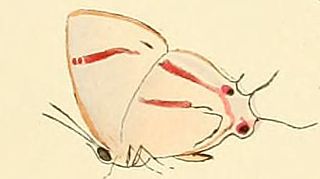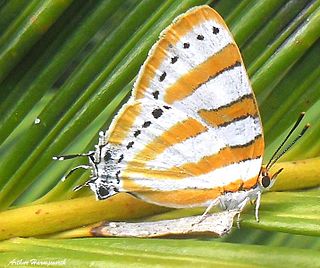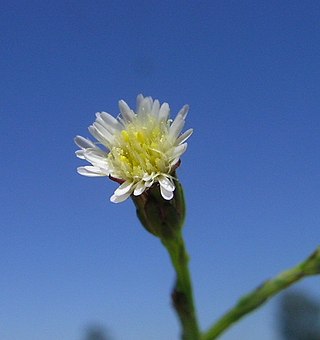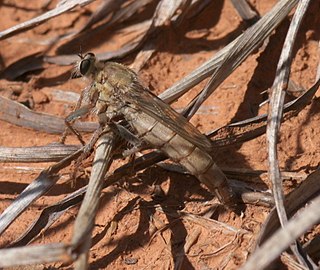
Gnathosaurus is a genus of ctenochasmatid pterosaur containing two species: G. subulatus, named in 1833 from the Solnhofen Limestone of Germany, and G. macrurus, known from the Purbeck Limestone of the UK. Its fossil remains dated back to the Late Jurassic period.

The eastern woodhaunter, also known as the Amazonian woodhaunter, is a species of bird in the Furnariinae subfamily of the ovenbird family Furnariidae. It is found in Bolivia, Brazil, Colombia, Ecuador, Peru, and Venezuela.

Scleropogon is a monotypic genus of grass which includes the sole species Scleropogon brevifolius, or burrograss. This grass is found in two areas of the world, in North America from the southwestern United States to central Mexico and in South America in Chile and Argentina. This is a perennial mat-forming grass with sharp, tufted leaves and firm awns. This grass may be dioecious, with staminate and pistillate plants growing in separate colonies.

Melaleuca subulata is a plant in the myrtle family Myrtaceae, and is endemic to south eastern Australia.. It is a small, spreading shrub with hard bark, dense foliage, cylindrical leaves and spikes of dark crimson flowers in summer.

Iolaus sidus, the red-line sapphire or red-line sapphire blue, is a butterfly of the family Lycaenidae. It is found from South Africa to Mozambique, Zambia, Zimbabwe and then to Kenya and Uganda. In South Africa it is found from the coastal woodland in the Eastern Cape to Tongaland and Bedford, the thorn belt of KwaZulu-Natal and then to Eswatini and Mpumalanga.

Iolaus nasisii, the Nasisi sapphire or Zimbabwe yellow-banded sapphire, is a butterfly of the family Lycaenidae. It is found in the forest and savannah in the extreme north of Limpopo, north to Uganda, western Kenya, Tanzania, Malawi, northern Zambia, Zimbabwe, Botswana and Namibia (Caprivi).
Lioptilodes albistriolatus is a moth of the family Pterophoridae. In South America and Central America it has been recorded from Argentina, Brazil, Chile, Costa Rica, Cuba, Ecuador, Guatemala, Paraguay, Peru and Puerto Rico. It is also present in North America, where it is known from Mexico, California, Texas, New Mexico and Arizona. It is an introduced species in Hawaii.
Iolaus helenae is a butterfly in the family Lycaenidae. It is found in north-eastern Zambia.
Iolaus nolaensis is a butterfly in the family Lycaenidae. It is found in the Republic of the Congo, Tanzania and Zambia.

Symphyotrichum subulatum, commonly known as eastern annual saltmarsh aster or, in Britain and Ireland where it is naturalized, annual saltmarsh aster, is an annual plant in the family Asteraceae native to the eastern United States and the Gulf Coast to Texas. The species grows primarily in coastal salt marshes, although in the Ozarks it occurs as a non-marine weedy variety.

Crossocerus is a genus of square-headed wasps in the family Crabronidae. There are at least 250 described species in Crossocerus.
Sphenophorus subulatus is a species in the weevil family Curculionidae. It is found in North America.

Scleropogon is a genus of robber flies. There are about 17 described species in Scleropogon.
Scleropogon texanus is a species of robber flies.
Scleropogon kelloggi is a species of robber flies .It is found Texas and Arizona.
Gymnopternus subulatus is a species of long-legged fly in the family Dolichopodidae.
Scleropogon haigi is a species of robber flies.

Scleropogon picticornis is a species of robber flies.
Scleropogon bradleyi is a species of robber flies.

Acrodon is a genus of ice plants from South Africa. It comprises five species, mostly endangered and all restricted to the southern Cape regions of the Western Cape and Eastern Cape Provinces, South Africa.











